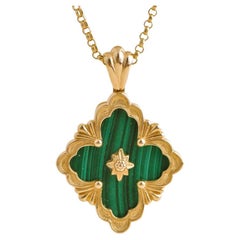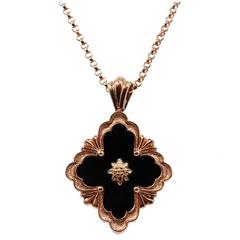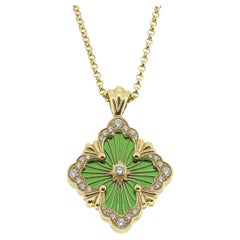Buccellati Opera Necklace
2010s French Pendant Necklaces
Malachite, 18k Gold, Yellow Gold
Recent Sales
21st Century and Contemporary Italian Pendant Necklaces
Onyx
21st Century and Contemporary Pendant Necklaces
Diamond, 18k Gold, Yellow Gold, Enamel
2010s Italian Pendant Necklaces
Diamond, Jade, 18k Gold, Gold
2010s French Pendant Necklaces
Turquoise, 18k Gold, Yellow Gold
20th Century Italian More Necklaces
18k Gold
21st Century and Contemporary Italian More Necklaces
Malachite, Gold
People Also Browsed
Mid-20th Century More Necklaces
Diamond, Cultured Pearl, Gold, 14k Gold, White Gold
2010s Italian Contemporary Cocktail Rings
Gold, 18k Gold, Yellow Gold
2010s Australian Artist Engagement Rings
Emerald, 18k Gold, Yellow Gold
2010s American Cocktail Rings
Diamond, White Diamond, 18k Gold, Yellow Gold
2010s American Contemporary Band Rings
Diamond, 14k Gold, Yellow Gold, Gold
1990s Drop Necklaces
Garnet, Rhodolite, 18k Gold
2010s French Pendant Necklaces
Yellow Gold
2010s French Pendant Necklaces
Chalcedony, 18k Gold, White Gold
21st Century and Contemporary French Chain Bracelets
Malachite, 18k Gold, Yellow Gold
Vintage 1970s European Retro Dangle Earrings
Diamond, Sapphire, 18k Gold, White Gold
Vintage 1980s Clip-on Earrings
Lapis Lazuli, Yellow Gold
20th Century Wrist Watches
Diamond, 18k Gold
2010s French Pendant Necklaces
18k Gold, Rose Gold
Late 20th Century Italian Modernist Cocktail Rings
Quartz, Lapis Lazuli, Yellow Gold, 18k Gold, Gold
2010s Italian Modern Cocktail Rings
Ruby, White Diamond, Diamond, Platinum
20th Century Swiss Artisan Pendant Necklaces
Diamond, White Diamond, Yellow Diamond, Sapphire, 18k Gold, White Gold
Buccellati for sale on 1stDibs
In 1919, Mario Buccellati (1891–1965) launched his eponymous jewelry house with the opening of his first shop in Milan and quickly built a reputation for his richly embellished traforato, or finely pierced goldwork. The Ancona, Italy–born jeweler’s workmanship was in a class of its own. His pieces were exquisite, yet the gemstones themselves were never too flashy, elevated instead by the designs’ intricate metalsmithing.
A love of tradition set Mario and his fine jewelry house apart in the competitive Italian market and remains a point of pride for the family, which is still closely tied to the business even as it is now owned by Richemont, a luxury conglomerate that also counts Cartier and Van Cleef & Arpels among its subsidiaries.
A young Mario Buccellati apprenticed with famed goldsmith Beltrami e Besnati in the early 1900s, although many of the goldsmithing techniques synonymous with Buccellati go as far back as the Italian Renaissance. The family lineage is also said to include 18th-century jeweler Contardo Buccellati.
Owing to the founder’s advanced metalworking skills, the brand is known for designs that feature metal with the delicacy of lace and draw on the wonders of the natural world. The house’s work is typified by intricate gemstone settings that emphasize their natural color and dense engraving techniques that transform the texture of gold.
One of the time-honored engraving techniques that has come to characterize Buccellati’s work — techniques that require apprenticeships and training in the fine jeweler’s workshops — is called rigato. It involves the engraving of a precious metal with a series of parallel lines to achieve a fabric-like effect.
Rigato is on luminous display in the house’s Macri collection of earrings, cuff bracelets and other accessories. A painstaking attention to detail is pronounced in the celebrated Macri, Bartolomeo and Unica collections — witness the striking honeycomb motif, a house signature, that characterizes the Unica collection’s Caterina bracelet, for example.
The Macri collection was the work of Mario’s son, Gianmaria Buccellati, an award-winning jeweler and internationally renowned silversmith who worked to bring the brand to the global stage by overseeing the opening of boutiques in Tokyo, Paris, California and elsewhere.
In 1951, Mario opened his first store in New York City; today the company operates boutiques worldwide. In 2019, the company celebrated its centennial with a new flagship in Paris and the Vintage collection, which features some of its most enduring designs.
On 1stDibs, find a collection of authentic Buccellati jewelry, including earrings, necklaces, rings and other accessories.
Why Gold Shines in Jewelry Craftsmanship
Gold is the feel-good metal, the serotonin of jewelry. Wear vintage and antique gold necklaces, watches, gold bracelets or gold rings and you feel happy, you feel dressed, you feel, well, yourself.
Gold, especially yellow gold, with its rich patina and ancient pedigree going back thousands of years, is the steady standby, the well-mannered metal of choice. Any discussion of this lustrous metal comes down to a basic truth: Gold is elementary, my dear. Gold jewelry that couples the mystique of the metal with superb design and craftsmanship achieves the status of an enduring classic. Many luxury houses have given us some of our most treasured and lasting examples of gold jewelry over the years.
Since its founding, in 1837, Tiffany & Co. has built its reputation on its company jewelry as well as its coterie of boutique designers, which has included Jean Schlumberger, Donald Claflin, Angela Cummings and Elsa Peretti. There are numerous gold Tiffany classics worth citing. Some are accented with gemstones, but all stand out for their design and the workmanship displayed.
For the woman who prefers a minimalist look, the Tiffany & Co. twist bangle (thin, slightly ovoid) is stylishly simple. For Cummings devotees, signature pieces feature hard stone inlay, such as her pairs of gold ear clips inlaid with black jade (a play on the classic Chanel black and tan), or bangles whose design recalls ocean waves, with undulating lines of lapis lazuli and mother-of-pearl. And just about any design by the great Jean Schlumberger is by definition a classic.
Even had he eschewed stones and diamonds, Southern-born David Webb would be hailed for the vast arsenal of heavy gold jewelry he designed. Gold, usually hammered or textured in some manner, defines great David Webb jewelry. The self-taught jeweler made very au courant pieces while drawing inspiration from ancient and out-of-the-way sources — East meets West in the commanding gold necklaces made by Webb in the early 1970s. The same could be said for his endlessly varied gold cuffs.
In Europe, many houses have given us gold jewelry that sets the highest standard for excellence, pieces that were highly sought after when they were made and continue to be so.
Numerous designs from Cartier are homages to gold. There are the classic Trinity rings, necklaces and bracelets — trifectas of yellow, white and rose gold. As a testament to the power of love, consider the endurance of the Cartier Love bracelet.
Aldo Cipullo, Cartier’s top in-house designer from the late 1960s into the early ’70s, made history in 1969 with the Love bracelet. Cipullo frequently said that the Love bracelet was born of a sleepless night contemplating a love affair gone wrong and his realization that “the only remnants he possessed of the romance were memories.” He distilled the urge to keep a loved one close into a slim 18-karat gold bangle.
BVLGARI and its coin jewelry, gemme nummarie, hit the jackpot when the line launched in the 1960s. The line has been perennially popular. BVLGARI coin jewelry features ancient Greek and Roman coins embedded in striking gold mounts, usually hung on thick link necklaces of varying lengths. In the 1970s, BVLGARI introduced the Tubogas line, most often made in yellow gold. The Tubogas watches are classics, and then there is the Serpenti, the house's outstanding snake-themed watches and bracelets.
A collection called Monete that incorporated the gold coins is one of several iconic BVLGARI lines that debuted in the 1970s and ’80s, catering to a new generation of empowered women. Just as designers like Halston and Yves Saint Laurent were popularizing fuss-free ready-to-wear fashion for women on the go, BVLGARI offered jewels to be lived in.
Since Van Cleef & Arpels opened its Place Vendôme doors in 1906, collection after collection of jewelry classics have enchanted the public. As predominantly expressed in a honeycomb of gold, there is the Ludo watch and accessories, circa the 1920s, and the golden Zip necklace, 1951, whose ingenious transformation of the traditional zipper was originally proposed by the Duchess of Windsor. Van Cleef's Alhambra, with its Moroccan motif, was introduced in 1968 and from the start its popularity pivoted on royalty and celebrity status. It remains one of VCA’s most popular and collected styles.
Mention must be made of Buccellati, whose name is synonymous with gold so finely spun that it suggests tapestry. The house’s many gold bracelets, typically embellished with a few or many diamonds, signified taste and distinction and are always in favor on the secondary market. Other important mid-20th-century houses known for their gold-themed jewelry include Hermès and Ilias Lalaounis.
Find a stunning collection of vintage and antique gold jewelry on 1stDibs.
Finding the Right Necklaces for You
We are fortunate to know much of the world’s long and dazzling history of necklaces, as this type of jewelry was so treasured that it was frequently buried with its owners. Today, Van Cleef necklaces, Tiffany necklaces and Cartier necklaces are some of the most popularly searched designer necklaces on 1stDibs.
Lapis lazuli beads adorned necklaces unearthed from the royal graves at the ancient Iraqi civilization of Sumer, while the excavation of King Tut’s burial chamber revealed a sense of style that led to a frenzy of Art Deco designs, with artisans of the 1920s seeking to emulate the elegant work crafted by Ancient Egypt’s goldsmiths and jewelry makers.
In ancient times, pendant necklaces worn by royalty and nobles conferred wealth and prestige. Today, wearing jewelry is about personal expression: Luxury diamond necklaces exude confidence and can symbolize the celebratory nature of a deep romantic relationship, while paper-clip chain-link necklaces designed by the likes of goldsmith Faye Kim are firmly planted in the past as well as the present. Kim works exclusively with eco-friendly gold, and these fashionable, fun accessories owe to the design of 19th-century watch fobs.
For some, necklaces are thought of as being a solely feminine piece, but this widely loved accessory has been gender-neutral for eons. In fact, just as women rarely took to wearing a single necklace during the Renaissance, men of the era layered chains and valuable pendants atop their bejeweled clothing. In modern times, the free-spirited hippie and counterculture movements of the 1960s saw costume-jewelry designers celebrating self-expression through colorful multistrand necklaces and no shortage of beads, which were worn by anyone and everyone.
Even after all of these years, the necklace remains an irrefutable staple of any complete outfit. Although new trends in jewelry are constantly emerging, the glamour and beauty of the past continue to inform modern styles and designs. In a way, the cyclical history of the necklace differs little from its familiar looped form: The celebrated French jewelry house Van Cleef & Arpels found much inspiration in King Tut, and, now, their Alhambra collection is a go-to for modern royals. Vintage David Webb necklaces — whose work landed him on the cover of Vogue in 1950, two years after opening his Manhattan shop — were likely inspired by the ornamental styles of ancient Greece, Mesopotamia and Egypt.
On 1stDibs, browse top designers like Dior, Chanel and Bulgari, or shop by your favorite style, from eye-catching choker necklaces to understated links to pearl necklaces and more.


